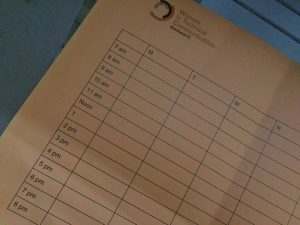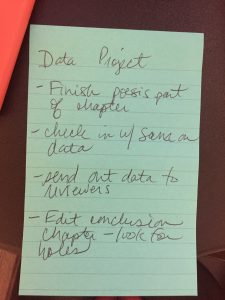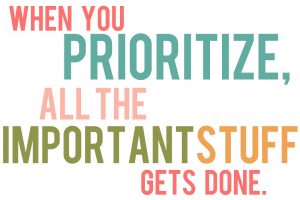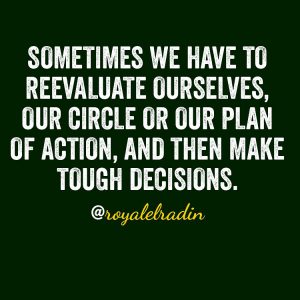Posted 25 March 2018 by Lisa Meloncon
With the ATTW luncheon and my other responsibilities at both ATTW and CCCCs, I’ve gotten “behind” on getting a blog up. (and seriously, if you have something to say, please get in touch because we would love to have folks participate here.)
 So today I’m gonna do something of a summary of the luncheon activity because it leads into an ongoing topic and concern of many, time management. At the luncheon, the topic was Values and Priorities. We did a couple of exercises where we asked participants to first write down what they valued both personally and professionally. The purpose of this activity was to get folks thinking about what is truly important to THEM in the their lives. Examples of this could include getting an article manuscript out each year or doing more community work or spending more quality time with children or significant others. We then moved to the barriers that can get in the way of what we value. Attendees were asked to write down some of the things that consistently get in the way of the things they value. We had table discussions around these ideas and then we moved to trying to create a schedule–and we gave attendees an actual weekly calendar–to see if they could brainstorm ways to make their values, priorities, and schedules align. The last activity was sharing a strategy to help align values and priorities to schedules. (Those strategies are gathered here.)
So today I’m gonna do something of a summary of the luncheon activity because it leads into an ongoing topic and concern of many, time management. At the luncheon, the topic was Values and Priorities. We did a couple of exercises where we asked participants to first write down what they valued both personally and professionally. The purpose of this activity was to get folks thinking about what is truly important to THEM in the their lives. Examples of this could include getting an article manuscript out each year or doing more community work or spending more quality time with children or significant others. We then moved to the barriers that can get in the way of what we value. Attendees were asked to write down some of the things that consistently get in the way of the things they value. We had table discussions around these ideas and then we moved to trying to create a schedule–and we gave attendees an actual weekly calendar–to see if they could brainstorm ways to make their values, priorities, and schedules align. The last activity was sharing a strategy to help align values and priorities to schedules. (Those strategies are gathered here.)
Needless to say, that the discussions at the tables were lively and encouraging (and discouraging because of the number of folks who felt they had little control over their time). As I have said many times, this job is hard and because of all sorts of pressures, we often feel the need to overproduce or we lose the focus on what is most important to us. All at the detriment of our mental, emotional, and/or physical health. The goal of the luncheon was to encourage folks to think through what they value and then try to find ways to shift their own work habits and potentially to set up new boundaries to enable schedules that we truly value.
After the luncheon several people asked me for suggestions on how I manage my time. Time management is the key to aligning our values with our schedules. None of what follows is new or innovative. But it does give insights into the process of approaching work that you may find useful in thinking through your own lives. Hopefully, you can find a nugget or two that can help you manage your workflow.
Find a Planner
I use planner here loosely because I get that many of you do things electronically, while the dinosaurs among us (like me!) still use the old school, in print, carry it around planner. The key is you need to use one. Electronic versions run the gamut from robust task management tools like Omnifocus or Things to more lightweight free tools like Todoist or Wunderlist to tools more specific to projects like Trello. Then you have the old school type of planners. I currently use an Action Day but I have used or tried or bought, examined, and returned so many of the others on the market such as Passion Planner, Panda Planner, At-a-glance, and the bullet journal approach.
The key to a good planner is that it needs space for
- weekly meetings and such: an actual day to day schedule with hours so you can block things off including writing and thinking time
- tasks for that week: we need to be able to see at a glance things you need to get accomplished in a week
- additional spaces: this means you can add parts of a project or ongoing administrative tasks that need to get accomplished
Here’s a blank page of my current planner and the way I’ve shifted it’s areas to fit my life and work.

So I use the planner’s “Tasks to Execute” on the left in the same way the planner creators intended as my weekly list of things that I have to get done. But the areas under the calendar I have changed to keep track of weekly things specific to life: RHM (items for the journal I co-edit); Program (things associated with my work as program administrator); Service (tasks specific to my service obligations such as work for womeninTC or CPTSC or locally on a committee); Emails (self explanatory). The calendar area is used to block of time for class, class prep, scheduled meetings, and writign and research time. Typically, a week is pretty filled from 8-5 with some space for when things get awry and stuff has to shift.
The planner then becomes your weekly/daily guide.
Sticky Notes and Whiteboards
I combine sticky notes and whiteboards because I use them both sort of equally and mostly for the same reasons. These are tools to get a bigger picture of life. These contain the deadlines you have coming up (that when they get closer need to be transferred into your planner) and then other smaller deadlines and some big picture goals. So currently, I have a whiteboard that lists the things I am working on with deadlines (both given to me and also those I’ve kind of tentatively assigned to that project). then I have some sticky notes that list parts of those projects that need to get done.

For example, I’m finishing up this big data project about programs that also makes some pretty pointed and provocative arguments about what TPC needs to do to sustain programs equitably and ethically. My whiteboard has that project listed along with several big component parts that still need to be done. My sticky note then has a list of some things that I need to do next week. But see, this project isn’t tied to anything but me wanting to get it done. So I use the sticky note so I can easily move it from week to week, and the whiteboard is the ever present reminder that it is in progress.
Here you can use most anything. I’ve also used a legal page taped the wall or a separate notebook. Project management scholarship and practice simply tells us that we need some system to keep track of the parts of the project. Using multiple tools in ways that make sense to you and your life ensures that you can break the projects down into manageable chunks that can be assigned daily and weekly slots so there is incremental and consistent movement forward. And some folks use sticky notes on white boards (which follows practices from project management in the workplace)!
The sticky notes and whiteboards or whatever you devise for yourself becomes your big picture and project management guides.
Prioritize
I have written before about making realistic schedules and plans. I wrote their that in the summer you need to cut your plan in half as a beginning move. The same holds pretty true for our work weeks. See, it always happens that we start to plan our weeks with the IDEAL scenario in mind, and the vast majority of weeks (I would guess upward of 85%) never even come close to the ideal. Why? Because, well, life. Things happen at school; things happen at home; someone gets sick; you just can’t find the focus you need for the project you laid out; unexpected meetings come up and on and on and on.
 Thus, the key to prioritizing is to realistically prioritize.
Thus, the key to prioritizing is to realistically prioritize.
- What projects do you need to get done based on where they are (e.g., does it make more sense to try to move the manuscript that is 60% done further along rather than work on the one that is just in the idea stage? OR does it make more sense to finish the programmatic work now rather than wait until just a couple of days before its due?)
- Will the meetings or tasks planned this week be more draining? If so, then don’t plan as much.
- Are you sleeping well and exercising? If so, then you’re likely to have more energy during the workday so you can plan a little more, but if NOT, then CUT BACK because you won’t get as much done.
- Did you account for prep time for meetings, for class, and for grading?
- What’s going on in the lives of those folks closest to you?
- Did you remember to schedule exercise or time to eat?
See what I’m trying to get at? The need for you to be more realistic when setting up your schedule by prioritizing those things that need to get done and what you want to get done. All the while by not forgetting that you need to care fo yourself (and your families).
Re-evaluate
 One of the lessons that took me YEARS to learn was that I had to (1) stick to a new approach to work for at least a couple of weeks and (2) then re-evaluate how it was working. One of the many tricky things about this job is that it changes from term to term and year to year. That’s a great thing because it encourages a consistent evaluation of what is working and what is not in relation to your time management, value, and priorities.
One of the lessons that took me YEARS to learn was that I had to (1) stick to a new approach to work for at least a couple of weeks and (2) then re-evaluate how it was working. One of the many tricky things about this job is that it changes from term to term and year to year. That’s a great thing because it encourages a consistent evaluation of what is working and what is not in relation to your time management, value, and priorities.
Something for all us to remember is that when we’re looking at what worked and what didn’t we have to be mindful about our own practices. By that I mean, be self reflective about why something isn’t working or why progress is not being made on certain projects or why we dread, dread, dread doing something, or why we procrastinate when we know we shouldn’t. This is a such an important part of the re-evaluation process. Understanding some of these stressors and barriers is the first step in trying to find solutions to overcome them.
The system that I have now has been working pretty well for a while, and with ongoing tweaks, I feel it will work for the near future. But I’ll also be re-evaluating at the end of the term as I look forward to things that will be going on in the fall that are different than now.
And the summer is its own thing a little different from the rest of the year.
So I encourage you to use the latter stages of the term to maybe try out new time management techniques.
Wishing you peace, joy, and health!